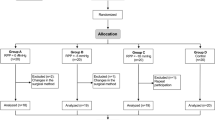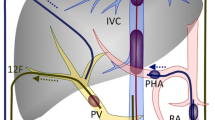Abstract
Purpose: Isolated pelvic perfusion (IPP) therapy exposes target tissues to high doses of anticancer drugs with low systemic concentrations, but the major drawback is drug leakage into the systemic circulation, which often thwarts the increased drug concentration. In this study, the efficacy of altering the in-out flow rate during IPP in order to decrease the leakage was assessed in adult pigs. Methods: The abdominal aorta and the infrarenal vena cava were occluded with two balloon catheters, blood in the extracorporeal circuit was circulated with twin rotary pumps, and the IPP was performed with platinum. Three sets of in-out flow rates were used, and the degree of drug leakage into the systemic circulation was evaluated. The volume of blood withdrawn was equal to the volume returned (300 ml/min; group A), 5% higher (group B), or 10% higher (group C). The platinum concentrations in the pelvic circulation, systemic circulation, and urine were measured and compared. Results: The average and maximum plasma platinum concentrations in the pelvic circulation did not significantly differ among the three groups. The plasma platinum concentrations in the systemic venous circulation of the three groups significantly (P<0.01) decreased as the volume withdrawn during IPP increased. The percentage of platinum eliminated in the urine during IPP was significantly (P<0.01) lower in group B and C than in group A. Conclusions: Setting the volume withdrawn higher than the volume returned decreased leakage into the systemic circulation under isolated pelvic perfusion.




Similar content being viewed by others
References
Austen WA, Monaco AP, Richardson GS, Baker WH, Shaw RS, Raker JW (1959) Treatments of malignant pelvic tumors by extracorporeal perfusion with chemotherapeutic agents. N Engl J Med 261:1037–1045
Collins JM (1989) Pharmacologic rationale for regional drug delivery. J Clin Oncol 2:498–504
Creech O, Krementz ET, Ryan RF, Winblad JN (1958) Chemotherapy of cancer: regional perfusion utilizing an extracorporeal circuit. Ann Surg 148:616–632
Guadagni S, Aigner KR, Palumbo G, Cantore M, Fiorentini G, Pozone T, Deraco M, Clerico M, Chaudhuri PK (1998) Pharmacokinetics of mitomycin C in pelvic stopflow infusion and hypoxic pelvic perfusion with and without hemofiltration: a pilot study of patients with recurrent unresectable rectal cancer. J Clin Pharmacol 38(10):936–44
Lawrence W Jr, Kuehn P, Mori S (1961) Regional perfusion of the pelvis: considerations of the leakage problem. Surgery 50:248–259
Lawrence W Jr, Clarkson B, Kim M, Clapp P, Randall HT (1963) Regional perfusion of pelvis and abdomen by an indirect technique. Cancer 16:567–582
Lingareddy V, Ahmad NR, Mohinddin M (1997) Palliative reiradiation for recurrent rectal cancer. Int J Radiat Oncol Biol Phys 38:785–790
Shingleton WW, Parker RT, Mahaley S (1961) Abdominal perfusion for cancer chemotherapy with hypothermia and hyperthermia. Surgery 50:260–265
Stehlin JS, Clark RL, White EC (1960) Regional chemotherapy for cancer: experience with 116 perfusions. Ann Surg 151:605–619
Turk PS, Belliveau JF, Darnowski JW, Weinberg MC, Leenen L, Wanebo HJ (1993) Isolated pelvic perfusion for unresectable cancer using a balloon occlusion technique. Arch Surg 128:533–539
Wanebo HJ, Belliveau JF (1999) A pharmacokinetic model and clinical pharmacology of cis-platinum, 5-fluorouracil and mitomycin-C in isolated pelvic perfusion. Cancer Chemother Pharmacol 43:427–434
Wanebo HJ, Chung MD, Levy AI, Turk PS, Vezeridis MP, Belliveau JF (1996) Preoperative therapy for advanced pelvic malignancy by isolated pelvic perfusion with the balloon occlusion technique. Ann Surg Oncol 3:295–303
Watkins E Jr, Hering AC, Luna R, Adams HD (1960) The use of intravascular balloon catheters for isolation of the pelvic bed during pump oxygenerator perfusion of cancer chemotherapeutic agents. Surg Gynecol Obstet 111:464–468
Wile AG, Smolin M (1987) Hyperthermic pelvic isolation-perfusion in the treatment of refractory pelvic cancer. Arch Surg 122:1321–1325
Wile AG, Stemmer EA, Andrews PA, Murphy MP, Abramson IS, Howell SB (1985) Pharmacokinetics of 5-fluorouracil during hyperthermic pelvic isolation-perfusion. J Clin Oncol 3:849–852
Wong CS, Cummings BJ, Brierley JD, Catton CN, McLean M, Catton P, Hao Y (1998) Treatment of locally recurrent rectal carcinoma: results and prognostic factors. Int J Radiat Oncol Biol Phys 40:427–435
Acknowledgements
This study was supported by the Program for Promotion of Fundamental Studies in Health Sciences of the Organization for Pharmaceuticals and Medical Devices Agency (PMDA) and the Grant-in-Aid for Cancer Research (1, 14-5) from the Ministry of Health, Labour and Welfare.
Author information
Authors and Affiliations
Corresponding author
Rights and permissions
About this article
Cite this article
Murata, S., Tajima, H., Kusakai, Gi. et al. Reduction of drug leakage by negative-balance isolated pelvic perfusion: correlation between leakage and in-out flow rate in a pig model. J Cancer Res Clin Oncol 131, 575–580 (2005). https://doi.org/10.1007/s00432-004-0666-4
Received:
Accepted:
Published:
Issue Date:
DOI: https://doi.org/10.1007/s00432-004-0666-4




